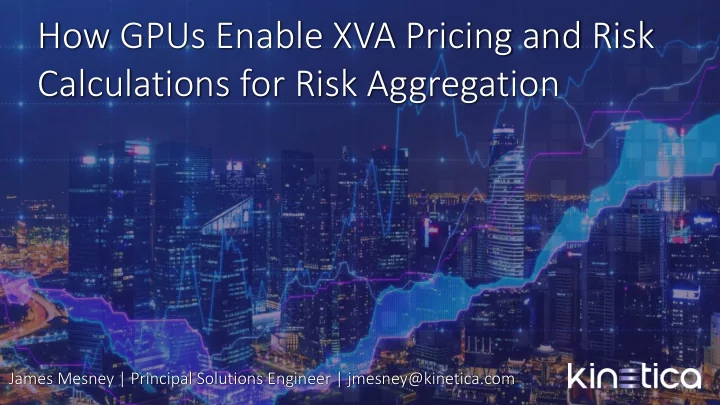

How GPUs Enable XVA Pricing and Risk Calculations for Risk Aggregation James Mesney | Principal Solutions Engineer | jmesney@kinetica.com
Setting the Scene
What is XVA? X-Value Adjustment ( XVA ) refers to “Valuation Adjustments” in relation to derivative instruments held by banks. The “X” in XVA means “ C” for credit, “D” for debt, “F” for funding, “K” for capital… “Doing” XVA is Risk Modelling. It’s all about computing potential RISK, now and in the future. OBJECTIVE: INSULATE THE BANK FROM RISK WHEREVER POSSIBLE AND ALLOCATE THE RIGHT CAPITAL 3
Why is XVA Needed? Pre 2007 - Trades cleared at fair valuations • Costs for capital and collateral were irrelevant to banks’ investment decisions • Increasingly complex investment portfolios emerge of variable value Post 2007 – MAJOR REFORM!! Counterparty Credit Risk and Basel III Accord Elevated Capitalisation + Collateralised Trades = EXPENSE & REDUCED PROFITABILITY! How can banks operate efficiently AND play by the rules? ANSWER=LOTS OF DATA + CLEVER FORECASTING MODELS, LOTS OF COMPUTE 4 4
XVA Challenges • To Compute Risk • Continually and comprehensively measure trading activity, currency movements • Consistently and timely – at trading speed… Batch processing is no longer satisfactory • 100,000s or millions of trades per day • 10,000s of counterparties… in 20+ currencies! • Calculations – Complex and Time Critical • Compute intensive workloads are well suited for the GPU • REAL TIME adjustment calculations are very computationally intensive • Monte Carlo Simulation 5 5
Life After Moore’s Law 40 Years of Microprocessor Trend Data 10 7 10 6 Transistors 10 5 1.1X per year (thousands) SpecINT 10 4 10 3 1.5X per year 10 2 Single-threaded perf 1980 1990 2000 2010 2020 Original data up to the year 2010 collected and plotted by M. Horowitz, F. Labonte, O. Shacham, K. Olukotun, L. Hammond, and C. Batten New plot and data collected for 2010-2015 by K. Rupp
The Rise of GPU Computing 10 7 GPU-Computing perf 1000X 1.5X per year 10 6 By 2025 10 5 1.1X per year SpecINT 10 4 10 3 1.5X per year 10 2 Single-threaded perf 1980 1990 2000 2010 2020 Original data up to the year 2010 collected and plotted by M. Horowitz, F. Labonte, O. Shacham, K. Olukotun, L. Hammond, and C. Batten New plot and data collected for 2010-2015 by K. Rupp
The CPU Bottleneck With limited processing gains on the horizon, CPUs are further and further behind the growth in data 8 8
GPU Acceleration Overcomes Processing Bottleneck 4,000+ cores per device versus ~16 cores per Parallel processing is ideal typical CPU for scanning entire dataset & brute force compute High performance computing trend to using GPU’s to solve massive GPU acceleration brings processing challenges high performance compute to commodity hardware 9
Deploying XVA
XVA Architecture BI / VISUALISATION ETL / STREAM PROCESSING Live Trading data KINETICA ‘REVEAL’ Native Counterparties APIs Options Currencies Futures PARALLEL INGEST ON DEMAND SCALE OUT + SQL Market BATCH & STREAMING DATA Foreign Exchange BI DASHBOARDS Bloomberg Server 'n' Reuters Export Server 1 Custom Connectors CUSTOM APPS In-Database Processing Python ML Libs Java SQL C++ BIDMach CUDA + DOWNSTREAM APPS XVA Model 11
Kinetica’s XVA Deployment at Major Multinational Bank Large financial institution moves counterparty risk analysis from overnight to real-time. Data collected and fed to XVA library which computes risk • metrics for each trade XVA outputs stored in Kinetica database • Flexible real-time monitoring by traders, auditors and • management Data retained for historic analyses, machine-learning… • 12
Financial Services: An Industry In Transition Three formidable forces—a weak global economy, digitization, and regulation —threaten to significantly lower profits by as much as $90B for the global banking industry over the next three years. Financial Services enterprises must reinvent their business by transforming the core – Resilience, Reorientation, Renewal Kinetica for: Resilience – Manage Revenue, Costs, Capital, and Risks Reorient – Customer-centricity, Digitization, Open Bank 13 Renewal - New Markets, Products, Customers Source: McKinsey & Co, PwC
Kinetica: A Distributed, In-Memory, GPU Database GPU-accelerated Natural language Native GIS and IP- Real time data database operations processing based address object handlers to ingest full-text search support structured and unstructured data Deep integration with open source No typical tuning, Predictable scale out Distributed visualization and commercial frameworks and indexing, and for data ingestion and pipeline built in applications: TensorFlow, Hadoop, tweaking querying Spark, NiFi, Storm, Kafka, Tableau, Kibana and Caravel 14
Kinetica Enabling Broad Enterprise Solutions CROSS INDUSTRY UTILITIES RETAIL/CPG FINANCIAL SERVICES Real-Time Analytics Omni-Channel Smart Meters Risk Modeling Converge AI & BI Customer Experience Smart Grid Optimization Financial Crimes Location-Based Analytics Infrastructure Modernization Supply Chain Optimization Compliance IoT Analytics Targeted Marketing Customer Experience MEDIA/ENTERTAINMENT COMMUNICATIONS TRAVEL HEALTHCARE Sentiment Analytics Customer Churn Price Optimization Drug Development Recommendation Engines Network Optimization Customer Experience Precision Medicine Ad Targeting Content Targeting Equipment Maintenance Patient 360 16
Kinetica: Unique Strengths & Capabilities Taking advantage of the parallel nature of the GPU Kinetica delivers low-latency, User-defined functions (UDFs) allow high performance analytics on large and for distributed custom compute steaming data sets directly from within the database. Fast, Distributed In Database Database Engine Analytics Supercharge Native Geospatial Simultaneously ingest, BI & Visualization explore, analyze, and visualize Easier to work with large Pipeline data within milliseconds to geospatial data sets. make critical decisions. 16
Thank You! Come get your Kinetica t-shirt and copy of the new O’Reilly book at booth G.01! James Mesney | Principal Solutions Engineer | jmesney@kinetica.com
Recommend
More recommend